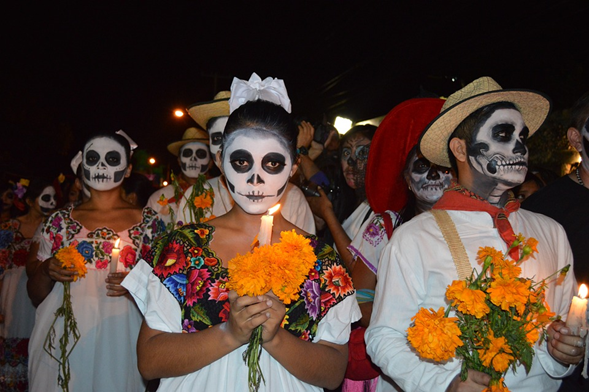The Day of the Dead is one of the most awaited and beautiful festivities that we celebrate as Mexicans on November 1st and 2nd. On this date, absence is not celebrated but the living presence of those who have departed and the return of their souls to our homes, represented in the altars.
The origin of this tradition dates back to prehispanic cultures. In ancient times, rituals were part of the civilization and they were present in every aspect of life. It was important for Mexicas to make a party when someone died to guide their soul to the Mictlan, the place to rest for souls of dead people, serving food in case they were hungry along the way. On the Day of the Dead, souls can return to earth to enjoy the dishes that their relatives made for them.
With the arrival of the Spaniards and the catholic religion, the celebration of the Day of the Dead of the different cultures such as Mexicas, Mixtecas, Zapotecas, Totonacas among others, was moved to All Saints’ Day in the Catholic calendar and All Souls’ Day, on November 1st and 2nd respectively. These dates coincided with the end of the agricultural cycle of corn, being this the main crop of the country and adding one more reason to celebrate.
It is a fundamental part to place altars in homes and in public spaces. The most elaborated ones usually have 7 floors or steps but is very common in small houses and spaces to find altars with one floor like a table. These are decorated with tablecloths, colourful papel picado and the well-known cempasuchil flower, representative of this season. On the altars are also placed photos of the people who have passed away, candles and dishes such as mole, tamales, pan de muerto, fruit, hot chocolate, sugar skulls and some of the dishes that the departed loved the most.
In the past, a path made of cempasuchil flowers was made from the cemetery to the houses so the deceased could follow it. Nowadays, the path is made from the entrance of the houses to the altar or simply around it. As a result of the catholic influence, a cross is traced on the floor or on the altar with petals of cempasuchil flower.
The Day of the Dead is considered a national holiday, so work and activities are suspended on this day and families generally gather to clean the graves of their deceased at the cemetery, socialize and eat together. It is also part of the tradition to dress up as a catrin or catrina. This consists of making up as if you were a skull and wearing traditional Mexican clothing, or elegant and ostentatious costumes. It is very common at this time of the year to see exhibitions and contests of altars and catrinas in schools and parks.
Such is the impact of this festivity not only in Mexico but worldwide, that in 2008 the United Nations Educational, Scientific and Cultural Organization (UNESCO) declared this festivity an Intangible Cultural Heritage of Humanity, as it is a celebration that unites the past and tradition of indigenous peoples with modern society, reinforcing cultural capital and national identity.
Finally, it is a celebration of remembrance that, although it is celebrated in different ways depending on the region and state, we will find all over the country, and of which we all feel very proud.


